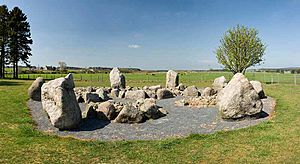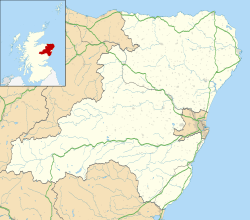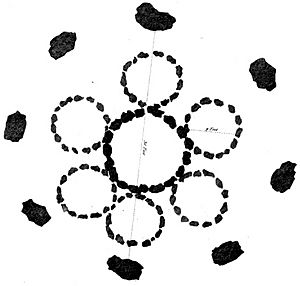Cullerlie stone circle facts for kids

The stone circle
|
|
| Location | Aberdeenshire, Scotland |
|---|---|
| Coordinates | 57°07′44″N 2°21′24″W / 57.12892°N 2.35661°W |
| Type | Stone circle |
| History | |
| Periods | Neolithic / Bronze Age |
| Site notes | |
| Website | Historic Environment Scotland |
| Official name | "Cullerlie stone circle", Standing Stones of Echt |
| Reference no. | SM90088 |
The Cullerlie stone circle, also known as the Standing Stones of Echt, is a small and unique stone circle. You can find it near Echt, Aberdeenshire in Scotland.
It has eight stones made of red granite. These stones are placed in a circle about 10 meters (33 feet) wide. Inside the circle, there are eight small piles of stones called cairns.
Each cairn has a ring of stones around it. The one in the middle has a double ring. Most of the cairns have eleven stones in their rings, but one has nine. The whole circle sits on a patch of gravel. This gravel patch is at the end of a low ridge.
Experts believe Cullerlie is a later type of stone circle. Its special design, with cairns inside the circle, makes it one of a kind.
Contents
What is the Cullerlie Stone Circle?
The Cullerlie stone circle is an ancient monument. It was built thousands of years ago. It is a special place where people in the past gathered.
How Was the Circle Built?
The Cullerlie stone circle was built in the second millennium BC. This means it was made between 2000 and 1001 BC. At that time, the land around it was very wet and marshy.
The stones used for the circle were brought from higher ground. They were carried some distance to the site. The tallest stone is on the north side of the circle. The stones range in height from about 1 meter (3.6 feet) to 1.8 meters (5.9 feet).
In 2004, a survey found something new. Several stones had special carvings on them. These are called cup marks. They look like small hollows or rings carved into the stone.
Building in Stages
Archaeologists dug up the site in 1934. H. E. Kilbride-Jones led this work. They found that the circle was built in different steps.
First, the entire area was cleared and made flat. Then, people burned piles of willow twigs on the ground. This helped to prepare the site.
Next, the large outer stones were put in place. Their bottoms were shaped to be pointy. This helped them stand strong in the gravel ground. Over time, the wet, peaty soil has worn down the lower parts of the stones.
After the stones were set, oak and hazel wood were burned inside the stone rings. This left charcoal behind. In five of the rings, burned human bones were placed in the ashes. Finally, smaller stones were used to fill these rings. This created the cairns you see today.
Were There Other Circles Nearby?
In 1820, a writer named James Logan wrote about Cullerlie. He said there were "nine others of similar dimensions" nearby. These would have been other small stone circles.
However, when the site was dug up in 1934, no trace of these other circles was found. It is possible they were destroyed over time. Or perhaps Logan's information was not entirely accurate.



